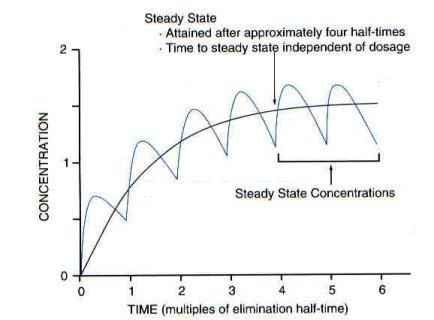- Joined
- Feb 29, 2012
- Messages
- 2
- Reaction score
- 0
Hello all. I would like to ask all the experts here a question regarding half-life. I understand the straight-forward math equation involved:
Half Life of a Medication = 6 hours.
50% remains in the system at 6 hours.
Divide that by two at 12 hours.
And so forth until zero.
But what happens when the numbers overlap at the next dose?
Say the individual takes 100mg of the medication every 12 hours. With an 6 hour half life you are still going to have 25mg in the body at 12 hours. Then you take another 100mg.
Does the clock then reset, at 125mg? Reducing to 62.5 after 6 hours? And 31.2 after 12 hours?
Only to take another dose, resulting in 131.2 in the body? And so forth ... ?
If this is not how it works, could you tell me why?
Lastly, when I think of some antibiotics which are taken for 5 days, and the doctor always states that it continues to "work" for 7 to 10 days, I assume this is because of the same phenomenon. Half life is aggregate.
True or False?
Half Life of a Medication = 6 hours.
50% remains in the system at 6 hours.
Divide that by two at 12 hours.
And so forth until zero.
But what happens when the numbers overlap at the next dose?
Say the individual takes 100mg of the medication every 12 hours. With an 6 hour half life you are still going to have 25mg in the body at 12 hours. Then you take another 100mg.
Does the clock then reset, at 125mg? Reducing to 62.5 after 6 hours? And 31.2 after 12 hours?
Only to take another dose, resulting in 131.2 in the body? And so forth ... ?
If this is not how it works, could you tell me why?
Lastly, when I think of some antibiotics which are taken for 5 days, and the doctor always states that it continues to "work" for 7 to 10 days, I assume this is because of the same phenomenon. Half life is aggregate.
True or False?
